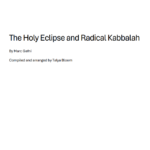The 15th day of Shevat: “Tell them that I was here Before”
by Marc Gafni
On the fifteenth day of Shevat we celebrate the planting of trees. A day of myriad symbols and images–all holy and sweet.
There are two ways to probe the essence of a holy day. One is as a scholar, the other as a spiritual anthropologist.
For the scholar, the Law is the gateway to understanding. The spiritual anthropologist, on the other hand, recognizes that the mysteries of holiness are captured not only in Law or text but in the tales and customs of the community canonized by the people over the centuries. It was this essential intuition that Buber understood when he took issue with Scholem’s analysis of Chasidut, primarily based on doctrine recorded in the formal writings of the movement. Buber argued that the living community, its mores and the stories they carry hidden tell us no less about a people’s philosophy.
Custom and tale move beyond law. They are the expression of the holy imagination of a holy people.
On the fifteenth day of Shevat, the Jewish people have a custom to eat of the fruit a carob tree.
Why a carob tree? The taste of a food holds within it meanings and morphic resonances which are sometimes inaccessible to more formal cognition. Proust in that classic passage from “Remembrance of Things Past” is able to recover lost images, meaning and even vitality through the taste of a Madeleine dipped in tea. So does our Carob hold a memory and a dream. Because in the collective Jewish consciousness a carob tree evokes a particular wisdom story in the memory of the people.
At the end of the Hasmonean dynasty, there lived a holy man who used to play before God. His name was Choni, the circle drawer and his story is told in the Talmud. (Ta’anit 23a)
One day Choni saw a man planting a carob tree and asked him, ‘How many years does it take for this Carob tree to bear fruit?’ ‘Seventy years,’ responded the man. To which Choni retorted, ‘Do you think you will live another seventy years and reap its fruit?’ To which the simple man responded, ‘I am planting the tree not for myself but for my Grandchildren.’
In the inner imagination of Jewish consciousness, planting trees, particularly carob trees is about Grandparents and Grandchildren and the messages they send each other. Thus on Tu B’shvat we eat the fruit of a carob tree.
But what is the message? What is the content of this dialogue between generations?
Let’s listen in on another story unfolding some eighty generations after the time of Choni the circle drawer.
Rabbi Ahaaron HaGadol of Karlin-Stolin lived a hundred years after the Baal Shem Tov, founder of the Chassidic movement.
Every school in Chassidut had its own path in the service of God. In Karlin-Stolin they would yell, cry, and scream at the top of their lungs during prayer. They did this to remove all thoughts from their minds which could detract from their complete focus on God during prayer.
In Karlin it was also the custom to daven the afternoon service very late, sometimes not beginning until long after the time prescribed by Jewish law. The Karliner Rebbe used to say, “When I come before the heavenly tribunal, if God asks me why I was always so late in Davening Mincha, I’ll ask God why is he so late in bringing the Messiah.”
One afternoon the Karliner Rebbe said to a few of his Chassidim, “Hitch up the horses, we are going on a Journey.”
“But Rebbe,” they responded, “it’s almost dark, we need to pray the afternoon service.”
“No matter,” responded the Rebbe, “we will pray when we arrive at our destination.” And so they began to travel. An hour, two and three go by. It’s long dark. “Rebbe, it’s almost midnight we need to daven Mincha.”
“In the next village,” said the Rebbe, “there we will pray.”
They soon arrived in the next village and the rebbe showed the way to a very small home on the outskirts of shtetel. A very old man opened the door.
“May we pray the afternoon service in your house?” asked the Rebbe.
“Please, I would be honored,” responded the villager.
And so was close to midnight when the Karliner and his chassidim began to pray. So ecstatic was their prayer that they forgot the hour. They prayed as they always did: screaming, yelling, and crying at the top of their lungs. All the peasants in the village woke up, thinking that a fire had broken out. They ran toward the Jewish Quarter with buckets of water.
When they got there they realized that this fire, that this fire at the house of prayer, was not a fire of destruction but a fire of healing.
The peasants moved by the passion and purity of the Chassidim’s prayer that they began to pray with them at the top of their lungs.
By the time prayers were over the peasants realized that the “Karliner” Rebbe was no ordinary man. They went to their homes and brought all sorts of food and drink to honor the Rebbe and his chasidim. And the Rebbe and his chasidim and the peasants all ate laughed and sang together through the night. A holy feast – it was as if the Messiah had already come.
When morning finally rolled around the Rebbe and his chassidim got back in the wagon, ready to return to Karlin.
Just then the Rebbe turned to the old man who had been there and said, “I came here because I was feeling confused. I prayed and somehow knew I had to come here, that you would have a message for me.”
And the old man began to speak. “Rebbe,” he said, “today is my 107th birthday. Exactly 100 years ago, on my seventh birthday, a man came with his followers to this very same place. He dressed differently than you and he spoke with a different accent. He even prayed differently than you did, but he too came at midnight to pray the afternoon service. And he too aroused the peasants to pray and feast with him. And before he left he put his holy hands on my head and looked into my eyes. ‘In exactly a hundred years from now,’ he said, ‘a holy master will come with his disciples to pray the afternoon service at midnight. He too will arouse the whole village to pray with him. Please,’ said the Holy Man, whose name was Israel son of Eliezer and Chanah, the Baal Shem Tov, ‘Please tell him that I was here before, tell him that I was here before.'”
The carob is about the covenant between generations. Classically the covenant is understood as the commitment of mutuality between God and the Jewish people: “To keep the Sabbath for the generations, a covenant of eternity between me and the children of Israel.”
Chassidut rereads the last phrase, “between me and between the children of Israel.” “Themselves” – that is a covenant between the generations. Every Jewish grandfather and grandmother commits to plant a carob tree for their grandchildren. Every Jewish grandchild commits to still be there seventy years later, to receive the fruit of the Carob tree and forge a another link in the eternal story of the Jewish people.
The links between generations are complex. There is no promise of doctrinal fealty or even full normative continuity. There is only a promise of engaged presence. This textured nuance of the covenant between the generations is captured most elegantly not in formal doctrine, but again in the primal symbols of the people.
The page of Talmud is arguably the overriding symbol of what Soloveichik termed the “Mesorah Community,” the community of transmission. The page contains three major texts. The central text both spatially and existentially is the Aramaic text of the Talmud itself. On the right side of the page, always near the binding, is the interpretive commentary of Rashi. On the left side is Tosofot, a school of thinkers who take issue with virtually every major position put forth by Rashi on the page, positions on matters theological, legal, and moral. The stunning paradox of continuity however lies in the fact that nowhere on the page states that the writers of Tosofot were Rashi’s grandchildren. The old Grandfather and his grandchildren are arguing passionately across the boundaries of time. The only commitment is a promise of presence, to both remain present on the same page; a covenant between the generations.
At every juncture in our lives we are both grandchild and grandparent, leaving messages for those unborn and receiving the messages that were left for us. Nachman of Bratzlav, the 19th century Kafka of Chassidut, writes, “Sometimes in one generation there is a question with no answer. In a later generation there is another question asked again with no answer. The second question however may well be the answer to the first, or vice versa.”
Ultimately that is why our archetypal father, Abraham, is chosen by God to be the first Jew. He wasn’t the first to worship one God. He wasn’t the first to know a truth. But he was the first religious personality in the Bible who succeeds in transmitting his values and passions to not only his child but to his grandchild. He was the first one who succeeded in leaving a message for his grandson: “Jacob, sweet lonely and confused Jacob, I WANT YOU TO KNOW – that I was here before.” And Jacob is the first Jewish Grandchild who eats the fruit of the carob tree. He receives the message and passes it on, beginning the never-ending story of the Jewish people.
Presented by Marc Gafni








